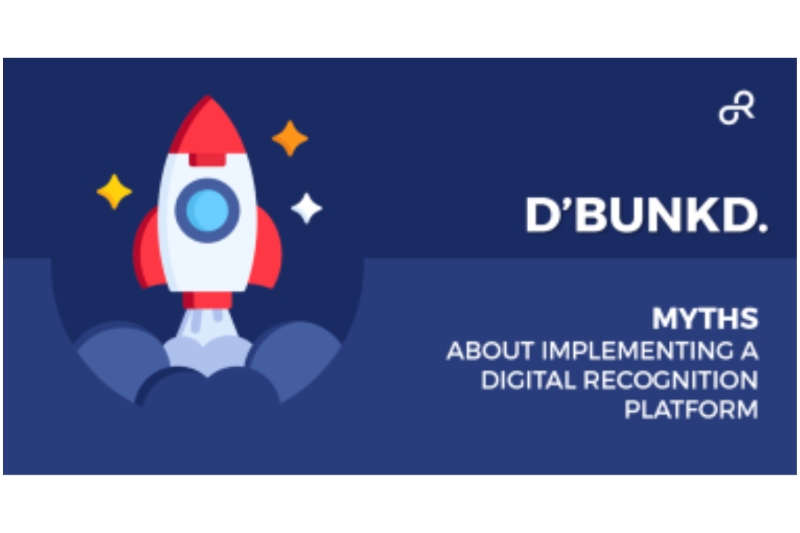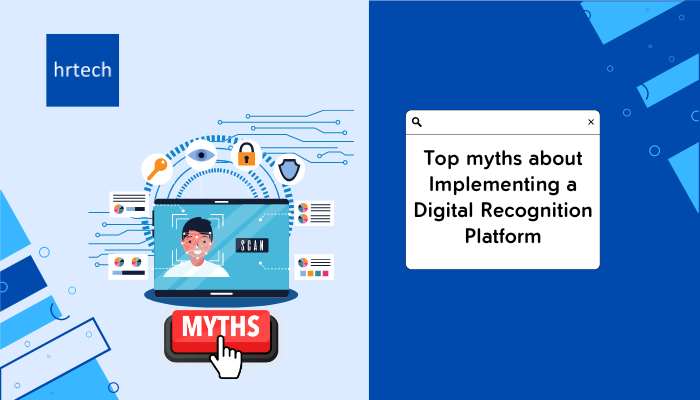A digital employee recognition platform complements your recognition framework and offers modular features. Ensure internal support, treat your employees as customers when launching the platform, and continuously leverage its features.

Business continuity remains a top concern of many organisations following the COVID-19 outbreak. With companies accelerating their digital transformation journey using technology to support work from home initiatives, being able to communicate with and engage employees is critical. Digital recognition is now acknowledged to be not just a buzzword, but also a critical means of complementing traditional engagement efforts. Nonetheless, due to the avant-garde nature of this technology and its soaring success, this space remains shrouded in myths. Today, we will review and debunk the top 5 misconceptions about implementing a digital recognition platform.
Myth #1: Digitise your full recognition framework if you are investing in a platform; otherwise, don’t bother.
While full immersion appears attractive at first glance, a phased implementation approach is more realistic. When introducing a new digital platform, familiarising employees with its features and processes will ensure that they can participate in this new mode of internal organisation with confidence and enthusiasm. Face-to-face recognition is still an effective tool for boosting morale. Once the current situation is under control and the social distancing measures are relaxed, annual awards dinners and other intermittent events should continue to be organised even as this technology is adopted. At the end of the day, digital engagement efforts must be integrated with and complement offline engagement initiatives.
Myth #2: The more holistic its capabilities, the better the platform.
More is not always better; sometimes it is just more. Opting for an all-in approach with exhaustive features and extended capabilities from the onset not only confuses priorities but also complicates the adoption process. Instead, companies should focus on selecting a platform that provides adequate configurability and modularity. Concentrating on these two aspects, instead of the complex capabilities that a program claims to offer, will allow management to select a platform that can adapt to its existing company culture and employee rewards and recognition programs while simplifying the roll-out process.
Myth #3: Selecting the best recognition platform is the most critical part of the digitisation strategy.
A tool can only be useful if it is used! While selecting a platform that meets your business needs is obviously an important part of a successful engagement strategy, an equally (if not more) important priority is to align the company’s stakeholders for effective implementation. Internal buy-ins, alignment from key stakeholders, adequate employee training, change management initiatives, and a robust project management approach will bolster the efficacy of your digital engagement platform. Investing capital in the best platform without securing proper internal support would yield poor returns.
Myth #4: Sending employees their login details via email is enough to get them to start using the platform.
When was the last time you immediately acted on an email asking you to login to a new platform? Need we say more?
Think of your digital employee recognition program like a social media app. As with any other app/platform that follows the technology adoption life cycle (TALC), capturing the early majority to convincing the laggards needs more than a simple sign-up process or email. User engagement and enthusiasm are critical for successful implementation. Introducing a platform is nothing short of a customer launch event—something that sparks excitement and anticipation instead of triggering fear or worse, apathy! Engage your employees face-to-face to create a memorable experience. A mere email will get lost in the fray.
Myth #5: Once the recognition platform is launched, it works on auto-pilot; the job is done.
No engagement initiative can be fully automated. One of the key benefits of digitising your engagement efforts is the ability to measure outcomes and gather data to fine-tune your initiatives. An employee recognition program is a live strategy—it must be nimble and dynamic, with new initiatives and features added regularly based on the data collected and analysed. Of course, this needs a clear ‘project owner’ within the company, who is responsible for driving digital engagement. Moreover, once a capability is unlocked on your digital platform, be sure to leverage it in favour of offline channels in order to drive continuous platform usage. This will incentivise employees to stay engaged with the platform. In short, engagement requires continuous effort. Technology enables but cannot replace this process.
Digital recognition increases employee engagement and efficiency multi-fold, while being measurable and insightful. Rewardzhas enabled over 150 clients across 19 countries to engage not only their employees, but also sales teams and customers through our modular and configurable digital platform, CERRA Points, and dynamic implementation strategies. And we continue to bust these myths, one client at a time.
Note: The ideas presented in this article are based on our cumulative experience in empowering numerous companies to digitally engage, recognise and reward their employees, sales teams, and customers across 19 countries, including Singapore, Malaysia, UAE, and more.
The Blog was originally posted by the Author here.
About the author :

Sudhanshu Tewari is the CEO of Rewardz, a mobile-first technology company that provides digital incentives to help companies build strong relationships with their employees, clients, sales teams, and partners while aligning behaviours with corporate values to drive a high-performance culture.
Along with his co-founders, Nicole Seah & Jaya Maru, Sudhanshu established Rewardz in 2012 and bootstrapped it to become one of the largest players in rewards and recognition solutions across Asia. Recognized for its analytics-driven employee engagement solutions and for creating change through positive reinforcement and gamification, Rewardz serves 150 clients across 19 countries and more than 250,000 users.
Sudhanshu hails from a banking background with over a decade of experience with reputable investment banks, including JP Morgan, RBS, and Credit Suisse.
Connect with him on LinkedIn




